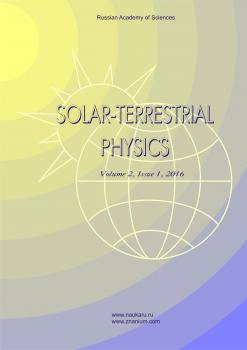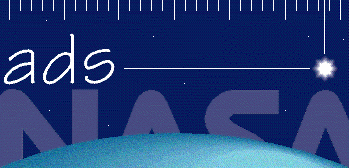Irkutsk, Russian Federation
I address the ion dynamics at the front of magnetosonic shocks moving at different angles θ to the magnetic field vector. I employ a shock discontinuity model in which the ramp potential difference is taken into account. The analysis conditionally separates all the ions incoming to the front of oblique magnetosonic shocks into the following categories: 1) transient, 2) reflected, 3) gyrating in front of the ramp, 4) pickup in the ramp. Both gyrating and pickup ions are shown to be present temporarily at the magnetosonic shock front at any angles θ. In the end, both the former and the latter appear to be transient in a strictly transversal magnetosonic shock; and either transient or reflected, in an oblique magnetosonic shock. I have found the critical angle θ* that separates ions into transient and reflected in an oblique magnetosonic shock. The critical angle θ* depends both on the velocity of the particles, incident on ramp, and on dimensions of the ramp potential difference. The most important results are that I have identified the physical cause of the production of the reflected ions having a significant energy and have revealed the mechanism for their acceleration in the ramp (surfing). In the near-Earth shock ion foreshock, these very ener-getic ions (from tens to hundreds of keV) escaping from the magnetosonic shock front at a small angle to the front plane manifest themselves in observations in the form of so-called field-aligned beams (FABs) and form the ion foreshock boundary.
shock, structure of magnetosonic shock front, accelerated particles
1. Alekseyev I.I., Kropotkin A.P. Passage of energetic particles through a magnetohydrodynamic discontinuity surface. Geomagnetism and Aeronomy. 1970, vol. 10, p. 755.
2. Bale S.D., Mozer F.S. Measurement of large parallel and perpendicular electric fields on electron spatial scales in the terrestrial bow shock. Phys. Rev. Lett. 2007, vol. 98, iss. 20, id. 205001. DOI:https://doi.org/10.1103/PhysRevLett.98.205001.
3. Bale S.D., Balikhin M.A., Horbury T.S., Krasnoselskikh V.V., Kucharek H., Mobius E., Walker S.N., Balogh A., Burgess D., Lembege B., Lucek E.A., Scholer M., Schwartz S.J., Thomsen M.F. Quasi-perpendicular shock structure and processes. Space Sci. Rev. 2005, vol. 118, pp. 161-203. DOI:https://doi.org/10.1007/s11214-005-3827-0.
4. Balikhin M., Gedalin M., Krasnosselskikh V. The scales in quasiperpendicular shocks. Adv. Space Res. 1995, vol. 15, pp. 247-260.
5. Balogh A., Treumann R.A. Physics of Collisionless Shocks. New York, Springer Science Business Media, 2013, 512 p. DOI:https://doi.org/10.1007/978-1-4614-6099-2.
6. Chiueh T. Multiple-encounter shock-drift acceleration in nearly perpendicular shocks. Astrophysical J. Pt. 1. 1988, vol. 333, pp. 366-385.
7. Dawson J.M., Katsouleas T. Unlimited electron acceleration in laser-driven plasma waves. Phys. Rev. Lett. 1983, vol. 51, pp. 392-396.
8. Decker R.B. Computer modeling of test particle acceleration at oblique shocks. Space Sci. Rev. 1988, vol. 48, pp. 195-262.
9. Erokhin N.S., Moiseev S.S., Sagdeev R.Z. Relativistic surfing in nonuniform plasma and generation of cosmic rays. Sov. Astronomy Lett. 1989, vol. 15, no. 1, pp. 3-6.
10. Gosling J.T., Thomsen M.F., Bame S.J., Feldman W.C. Evidence for specularly reflected ions upstream from the quasi-parallel bow shock. Geophys. Res. Lett. 1982, vol. 9, pp. 1333-1336. DOI:https://doi.org/10.1029/GL009i012p01333.
11. Heppner J.P., Maynard N.C., Aggson T.L. Early results from ISEE-1 electric field measurements. Space Sci. Rev. 1978, vol. 22, pp. 777-789.
12. Kichigin G.N. Investigation of the ion acceleration process at a front of magnetoacoustic wave with an isomagnetic discontinuity. Sov. Phys. JETP. 1992, vol. 74, pp. 793-814.
13. Kichigin G.N. Properties of surfatron acceleration of electrons. JETP. 1995, vol. 81, no. 4, pp. 736-744.
14. Kichigin, G. N. Surfatron mechanism of acceleration of cosmic rays in galactic plasma. JETP. 2001, vol. 92, no. 6, pp. 895-903.
15. Kichigin G.N. Surfing and generation of cosmic rays in relativistic shock waves. 2009a, JETP, vol. 109, no. 3, pp. 408-417.
16. Kichigin G.N. On an origin of energetic particles in the foreshock region of the Earth’s bow shock. Astronomy Lett. 2009b, vol. 35, no. 4, pp. 261-269.
17. Lee M.A., Shapiro V.D., Sagdeev R.Z. Pickup ion energization by shock surfing. J. Geophys. Res. 1996, vol. 101A, pp. 4777-4789.
18. Lever E.L., Quest K.B., Shapiro V.D. Shock surfing vs shock drift acceleration. Geophys. Res. Lett. 2001, vol. 28, pp. 1367-1370.
19. Leroy M.M. Structure of perpendicular shocks in collisionless plasma. Phys. Fluids. 1982, vol. 26, pp. 2742-2753.
20. Leroy M.M., Winske D., Goodrich C.C. Wu C.S., Papadopoulos K. The structure of perpendicular bow shocks. J. Geo-phys. Res. 1983, vol. 87, pp. 5081-5094.
21. ErokNewbury J.A., Russell C.T., Gedalin M. The ramp widths of high-Mach-number, quasi-perpendicular collisionless shocks. J. Geophys. Res. 1998, vol. 103, iss. A12, pp. 29581-29594.
22. Ohsawa Y. Conditions for ion reflection in a large amplitude magnetosonic wave. J. Phys. Soc. Japan. 1990, vol. 59, pp. 2782-2789.
23. Sagdeev R.Z. Collective processes and shock waves in rarefied plasma. Rev. Plasma Phys. New York, Consult. Bur., 1966, vol. 4, pp. 23-58.
24. Schwartz S., Thomsen M.F., Gosling J.T. Ions upstream of the Earth’s bow shock: a theoretical comparison of alternative source populations. J. Geophys. Res. 1983, vol. 88, no. A3, pp. 2039-2047.
25. Sckopke N., Paschmann G., Bame S.J., Gosling J.T., Russell C.T. Evolution of ion distributions across the nearly perpendicular bow shock: specularly and non-specularly reflected ions. J. Geophys. Res. 1983, vol. 88, pp. 6121-6136. DOI:https://doi.org/10.1029/JA088iA08p06121.
26. Shapiro V.D., User D. Shock surfing acceleration. Planet. Space Sci. 2003, vol. 51, pp. 665-680.
27. Sugihara R.S., Takeuchi N., Sakai K., Matsumoto M. de Acceleration of charged particles by an electrostatic wave propagation obliquely to a magnetic field. Phys. Rev. Lett. 1984, vol. 52, pp. 1500-1503. DOI:https://doi.org/10.1103/PhysRevLett.52.1500.
28. Toptygin I.N. Acceleration of particles by shocks in a cosmic plasma. Space Sci. Rev. 1980, vol. 26, pp. 157-213.
29. Webb G.M., Axford W.I., Terasawa T. On the drift mechanism for energetic charged particles at shocks. Astrophys. J. 1983, vol. 270, pp. 537-553.
30. Wilson III L.B. Low frequency waves at and upstream of collisionless shocks. Low frequency waves in space plasmas. (GMS-216)-AGU-2016, pp. 269-292.
31. Woods L.C. On double structured, perpendicular, magneto-plasma shock waves. Plasma Phys. 1971, vol. 13, pp. 289-302. DOI:https://doi.org/10.1088/0032-1028/13/4/302.

















